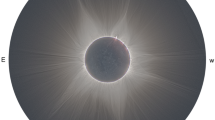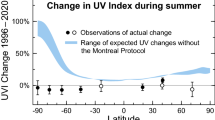Abstract
The He 1083 nm line equivalent width and the 10.7 cm radio flux are employed to model the total solar irradiance corrected for sunspot deficit. A new “area dependent photometric sunspot index” (APSI) based on sunspot photometry by Steinegger et al. (1990) is used to correct the irradiance data for sunspot deficits. Two periods of time are investigated: firstly, the 1980–1989 period between the maxima of solar cycles 21 and 22; this period is covered by ACRIM I irradiance data. Secondly, the 1978–92 period which includes both maxima; here, the revised Nimbus-7 ERB data are used.
For both He 1083 nm and 10.7 cm radio flux irradiance models as well as ACRIM I and ERB irradiance data, the APSI yields an improved fit compared to the one obtained with the standard “Photometric Sunspot Index” (PSI) which uses a constant bolometric spot contrastα. With APSI, the standard deviation calculated from daily values is 0.461 Wm−2 for the period 1980–89 modelling ACRIM I vs. He 1083 nm, as compared to 0.478 when PSI is used, and to 0.531 for the uncorrected ACRIM series. A similar improvement is obtained for the same period modelling ERB vs. He 1083 nm, while there is almost no improvement for the long period.
As a general result the models provide a good fit with the spot-deficit.-corrected irradiance only during the period between the maxima. If both maxima are included (period 1978–92) the He 1083 nm and 10.7 cm radio flux models show appreciably larger discrepancies to the irradiances corrected for PSI or APSI.
Similar content being viewed by others
References
Brandt, P.N., Schmidt, W., and Steinegger, M.: 1992, ‘Photometry of Sunspots Observed at Tenerife’ in R.F. Donnelly, ed(s).,Proceedings of the Workshop on the Solar Electromagnetic Radiation Study for Solar Cycle 22, NOAA/ERL/SEL: Boulder, 130.
Foukal, P. and Lean, J.: 1988,Ap. J. 328, 347.
Hoyt, D. V., Kyle, H. L., Hickey, J.R., and Maschhoff, R.H.: 1992,J.G.R. 97, 51.
Hudson, H.S.: 1988,Adv. Space Res. 8, 15.
Hudson, H.S., Silva, S., Woodard, M., and Willson, R.C.: 1982,Solar Phys. 76, 211.
Pap, J., Willson, R.C. and Donnelly, R.F.: 1992, ‘Two-Parameter Model of Total Solar Irradiance Variation over the Solar Cycle’ in K. Harvey, ed(s).,Proceedings of the NSO/Sac Peak 12th Summer Workshop, ASP Conference Series 27, 491.
Steinegger, M., Brandt, P.N., and Schmidt, W.: 1990,Astrophys. Space Sci. 170, 127.
Willson, R.C. and Hudson, H.S.: 1991,Nature 351, 42.
Author information
Authors and Affiliations
Rights and permissions
About this article
Cite this article
Brandt, P.N., Stix, M. & Weinhardt, H. Modelling solar irradiance variations with an area dependent photometric sunspot index. Sol Phys 152, 119–124 (1994). https://doi.org/10.1007/BF01473193
Issue Date:
DOI: https://doi.org/10.1007/BF01473193




